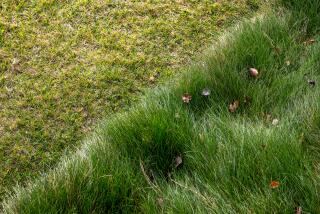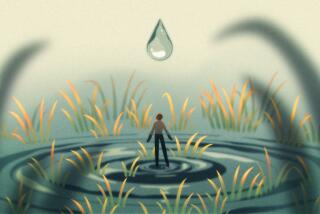Watering is probably the most demanding chore...
- Share via
Watering is probably the most demanding chore of summer. Keep in mind that deep watering is better for plants and easier on the gardener. It means watering less often but watering longer. Established lawns can get by on a once-a-week schedule, except during the hottest of weather. Check the soil with a trowel or a spade to determine how deep the water is sinking. If you’re watering trees and shrubs, you can attach a water spike to the hose and push it downward into the soil as the earth softens. It is easy to use, saves water (little evaporation) and gets to the roots.
Mulching is an attractive way to conserve water and keep weeds under control. It also shades the soil and keeps roots cooler. Water the soil well before putting down a mulch, and afterward, water again. You can buy mulches at nurseries, or you can make your own from leaves and lawn cuttings, which should be composted before using. Spread out the grass cuttings and allow them to dry and turn brown before adding them to the compost pile. The addition of a little nitrogen will speed the decomposition process.
Spraying a lawn for pests or fleas? The insecticide will be more effective if the lawn is mowed first. But be sure to read and follow the instructions, because you are dealing with a poison. If you have children or cats, you’d do well to follow the application with a light spraying of water on the surface of the grass, so that the insecticide goes to the ground. Most dogs will not be affected by residual poisons on the lawn; cats, however, often lick themselves after walking through an area that has just been sprayed. Moreover, cats are smaller than most dogs and are frequently less resistant to many poisons.
Daylilies are in bloom now, and one can see the tremendous strides that have been made in terms of choice of color and choice of size. There is a range of color from mahogany and orange through melon pinks to yellows, creams and near-white. There are also many new dusty purples and lavenders. And many daylilies are two-toned. They are among the easiest and most rewarding plants to grow. Also, Cordon Bleu Farms, P.O. Box 2033 San Marcos, Calif. 92069, has an extensive catalogue that they will send you for $1. Many of the new daylilies are deciduous, so check to determine whether or not they are before buying. (I plant the deciduous varieties two or more feet apart for winter and spring color. Paper whites, Dutch iris and early daffodils can be planted in between; when their foliage starts to die, it will be covered by fresh daylily foliage.)






